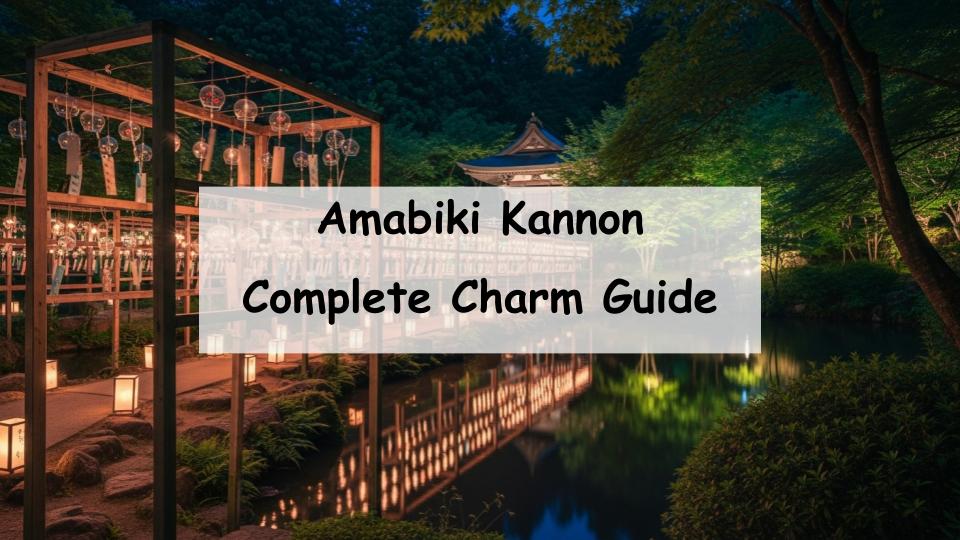“What’s Amabiki Kannon really like?” “Is it true that it brings blessings for safe childbirth and child-rearing?” “Is it easy to get there?”
If you’ve been asking these questions, you’re not alone.
To answer them upfront—Amabikiyama Rakuhoji Temple, commonly known as Amabiki Kannon, is a revered temple with over a thousand years of history, located in Sakuragawa City, Ibaraki Prefecture. It’s famous for its blessings related to safe delivery, child-rearing, and protection from misfortune, attracting visitors from all over Japan.
In this article, we’ll explore the history and religious background of Amabiki Kannon, the temple’s stunning architecture and nature-rich grounds, its annual events, and how to get there. Whether you’re a first-time visitor or a returning pilgrim, this guide will help you experience the temple fully.
What is Amabikiyama Rakuhoji Temple? History and Overview
Origins and Founding Legend
Amabikiyama Rakuhoji traces its origins back to the late 6th century during the reign of Emperor Yomei. It is said to have been founded by Hōrin Dokusho Koji, a monk from China. Despite numerous disasters and reconstructions, the temple has survived for over a millennium as a center of devotion and peace.
Sect and Principal Image
The temple belongs to the Tendai sect of Buddhism and enshrines Enmei Kannon Bosatsu (Kannon of Long Life) as its principal deity. Worshippers seek blessings here for health, longevity, safe childbirth, and child-rearing, making it a spiritual hub for families.
Alternate Name and Religious Significance
Known affectionately as “Amabiki Kannon,” the temple is deeply rooted in the local culture and faith. Beyond childbirth-related prayers, it is also believed to bring blessings for warding off evil and academic success.
Highlights of Amabiki Kannon: What to See and Experience
The Main Hall and Temple Architecture
The main hall is a beautifully preserved wooden structure that embodies the elegance and spiritual solemnity of traditional Japanese temple architecture. Other structures, such as the gate and bell tower, offer visitors a tangible sense of the temple’s long history.
Peacocks and Harmony with Nature
One of the most unique aspects of Amabiki Kannon is the presence of live peacocks roaming freely in the temple grounds. The peacocks, combined with the seasonal flowers and pond scenery, create a peaceful and photogenic atmosphere.
Blessings for Childbirth and Parenting
Amabiki Kannon is famous as a guardian deity for safe childbirth and child-rearing. Visitors can pray at the main hall and receive amulets or ema (votive plaques) dedicated to their wishes. The temple also conducts ceremonies for postnatal prayers and Shichi-Go-San (children’s growth rituals).
Visitor Experiences and Testimonials
Many people who have prayed at the temple report safe deliveries and healthy children. The temple enjoys high praise in word-of-mouth reviews and continues to attract families seeking spiritual assurance.
Cultural and Historical Treasures of Amabikiyama Rakuhoji
Valuable Statues and Sacred Artifacts
Inside the main hall are ancient statues, including some from the Heian period, along with scrolls and other temple treasures. These items are considered culturally and spiritually significant, offering insight into centuries of Japanese Buddhism.
Important Cultural Properties
Some of the temple’s buildings are registered as Important Cultural Properties by the Japanese government. The architecture showcases traditional techniques and styles from the Edo period, making the site a must-visit for history lovers.
Connection to the Local Community
Beyond its religious role, Amabiki Kannon is deeply intertwined with the local community. It serves as a cultural and educational site and even as an emergency shelter in times of natural disaster.
Seasonal Events and Festivals
Cherry Blossoms and Hydrangeas in Spring
In spring, cherry blossoms adorn the temple grounds, followed by vibrant hydrangeas in early summer. These flowers, set against historic structures, offer breathtaking views and are especially popular for photography.
Summer Wind Chime Festival and Night Illumination
During summer, the temple holds a wind chime festival, filling the grounds with the gentle, refreshing sound of hundreds of chimes. At night, the temple is illuminated, creating a mystical and romantic atmosphere.
Year-round Ceremonies and Their Meaning
Throughout the year, various Buddhist ceremonies are held, including year-end and New Year’s rituals. Each event reflects deep spiritual traditions and offers a chance for self-reflection and prayer.
Access and Visitor Information
By Train and Bus
The nearest station is Iwase Station on the JR Mito Line. From there, buses or taxis will take you to the temple. During special events, direct bus services may be available, so checking the temple’s website beforehand is recommended.
By Car and Parking Information
For those traveling by car, Amabiki Kannon is about a 15-minute drive from the Sakuragawa-Chikusei Interchange on the Kita-Kanto Expressway. The temple has a spacious free parking lot, making it convenient for group and family trips.
Combine Your Visit with Nearby Attractions
A visit to Amabiki Kannon pairs well with other local sights, such as Mount Tsukuba or the historic streets of Makabe, known for its Edo-period charm. Together, these destinations create a well-rounded cultural and nature-themed day trip.
Explore Tsukuba and Makabe
Mount Tsukuba offers hiking and panoramic views, while Makabe’s preserved buildings and slow-paced atmosphere make for a relaxing stroll. These nearby spots complement the serenity of Amabiki Kannon perfectly.
Things to Know Before Visiting Amabikiyama Rakuhoji
Hours, Admission, and Closures
The temple is generally open from 8:00 AM to 5:00 PM, with free admission. Fees apply for specific prayers or amulets. The temple is open year-round but may limit access during inclement weather or major ceremonies.
Etiquette and Guidelines for Visitors
Visitors are asked to remain quiet and respectful, especially during prayer services. Avoid touching animals or plants, and follow all posted instructions. Respectful behavior helps maintain the temple’s sacred atmosphere.
Photography Spots and Rules
While many areas are open to photography, some spaces—especially during ceremonies—may prohibit it. Always follow posted signage and staff directions to ensure a respectful and enjoyable visit.






Comment